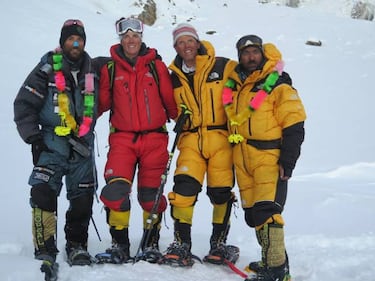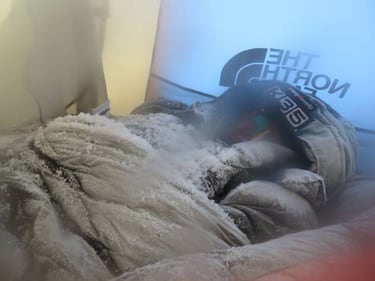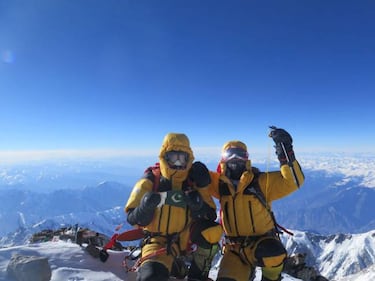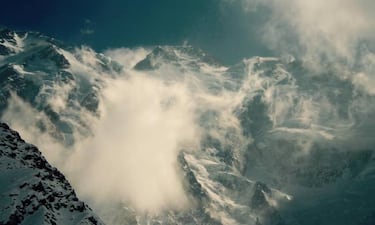"K2? I’m only thinking about getting home"
Alex Txikon made the first winter ascent of Nanga Parbat, the Killer Mountain, on 26 February. We spoke to him at base camp after the successful climb.

Alex Txikon (1981) made history this week on Nanga Parbat, the world's 9th highest mountain, along with Tamara Lunger, Simone Moro and Ali Sadpara, climbing the 8,126 metre peak for the first time in winter. Sebastián Álvaro spoke to him after his descent from the summit...
I caught him gathering up stuff at Base Camp. He tells me he’s got mild frost-bite on his nose, but our common friend, Dr. Ricardo Arregui, tells us it won’t cause any problems. I’m delighted that after so much effort and tension things have all turned out fine. For days we’ve been following his progression through the frozen world of Nanga Parbat, with our hearts in our mouths. No biggie: just the Killer Mountain, finally scaled in the depths of winter after 25 years of attempts.

I remember some of our moments together: in 2004 when I met him, while he was trying a tough route up K2, and he was putting up his tent in an avalanche prone gully. I told him it was suicide to stick a camp there. In exchange he volunteered himself for the tough task of bringing Juanito Oiarzabal, with frozen feet, off the mountain. The fastest rescue in the history of the Karakorum. Thanks to him and others like him, Juanito, without toes it’s true, is still climbing. From that point on he became one of the members for almost all of our expeditions for the TV show Al filo de lo imposible (On the edge of the impossible). He was one of us.
I remember fondly the peaks we shared in the Antarctic in 2006: Mount Wandell, Mount Mills and Mount Scott. Great times like few I’ve experienced in my life. I’m happy for the path this Basque, of parents from Málaga, has taken. He’s one of the most optimistic, strongest types I’ve ever known. The kind of guy who would go by car from the Basque Country to Pakistan in mid-winter, giving wood chopping demonstrations. A Basque aizkolari (lumberjack) in public squares in Iran, Austria and Pakistan. Because at heart, Alex is an alpinist with the soul of a wood-cutter.
The final attack on the summit was tough. How did you plan the logistics?
I think this expedition wasn’t as tough as last year’s. Probably we did things better too. We’ve worked hard right from the off, every day, but giving ourselves achievable goals. That’s how we coped with staying so long at Base Camp, but we never stopped, we knew we had to keep moving so as not to lose our acclimatisation or our fitness. The best proof of that is that on the final day we came down from Camp 4 (7,100m) to Camp 2 (6.150m) in two hours 20 minutes, and from C2 to C1 (4,800) in just two hours. I’ve learnt from the mistakes made: the tragedy on Hidden Peak (8.068) and last year on Nanga. The mistake of last winter when we got the route wrong and ended up 250m from the summit was one of the toughest lessons I’ve ever had, but also one from which I’ve learnt the most. That mistake was the basis of this success.
In these days that were so stressful, what was the toughest thing?
For me, the second night we spent at Camp 4 after coming down from the summit. We were so cold. It was almost unbearable despite all the clothes we had on, and probably, too, because we got to the tent on our last legs, absolutely destroyed. In the case of Tamara Lunger, literally, because she’d pulled up 100 metres from the summit, unable to go on, and she'd also had a fall, which luckily had no consequences. Although the forecast was was for 35 degrees below zero, I think it was colder. The wind was battering us at above 30 km/h which meant it felt like -40 degrees. We were in those conditions from six in the morning to seven in the evening

We summited around three in the afternoon, which taking into account the ice conditions we found on the summit dome, I think was a good time.
How did the team work? Alí Sadpara and you, with the duo Simone Moro and Tamara Lunger?
Exactly. The truth is that I’d talked to Simone some time ago about the possibility of going together, but when I looked with you at the possibility of reinforcing the team, when all the expeditions had already left and Danielle Nardi too, I realised that together we had a unique opportunity. I’m really pleased because the four of us made a great group, a team of four friends who didn’t just share a goal, but were also willing to give everything for it. I’m proud to have been with Simone, Tamara and my good friend Alí. I’m particularly proud that, because Alí summited, the porters of Baltistan are able to come out of the shadows and get as much attention as the Western climbers. I’m pleased Pakistan and Nanga Parbat will be known around the world thanks to a climbing success and the delight one of their own people brought to them, and not because of bombings or attacks. My only sadness is for Tamara, who got to 100 metres of the summit, literally exhausted. I feel so much for her, because she deserved it as much as we did. It was her chance to be the first woman to do a first winter ascent of an 8,000 metre peak, but she’s getting great support from Italy and from us too. Now K2 is the only one left that hasn’t been climbed in winter…

Of course there was lots of hard work and effort, but what was the key to the success?
The main thing was tenacity, persistence, trying again and again, believing I had the strength, being certain I could do it. This is my fifth year of winter ascents. After all the expeditions, it’s knowing how to carry on. Do you remember we once talked on El Larguero (a Spanish late night sports radio programme) about how we had to keep waiting for our chance. Well in the end we got that window of good weather we needed. Then, some small things, that in reality out there are massive: how the team moves, portage, and although we had bad weather we were consistent in equipping the route and the camps… And in the attack on the summit we were really disciplined in terms of eating and hydrating ourselves, that’s how we coped with the final day where we hardly ate or drank anything, because the cold was so intense we couldn’t take our mitts off.
Don’t you think that the choice of route was key to overcoming Nanga Parbat’s resistence? The Shell route, for example is fast in the lower part, but then it’s long and exposed higher up. The Messner route, followed this year by Tomeck Mackiewicz and Elisabeth Revol, is highly dangerous lower down and then really long up to the summit. The Rupal face, the choice of the Poles, is really tough and steep for a winter ascent…
I looked at the history of winter attempts on Nanga and I reached the conclusion that the Kinshofer route was the best to reach the summit in winter. I thought a lot about what we’d talked about in 2006 in Antarctica, when you’d come back from Nanga with the girls and you told me it was the best approach. And it is. There’s no doubt it’s tough down below, until you get over the Kinshofer wall, but then you can move directly to below the summit pyramid, and speed is vital in winter, because otherwise you freeze. What’s more the base camp is at 4,200 metres, and it’s one of the lowest and most beautiful in the Himalayas, and that allowed us to spend so much on the mountain.
What were you thinking when you were climbing towards the summit?
The truth is I was concentrating hard all the time. I didn’t want to think about anything other than climbing carefully, moving fingers and toes to make sure they didn’t freeze, avoiding slipping… The terrain was completely frozen and I was surprised at how steep the slope was up to the summit. There were areas of really hard ice and formations like the sastrugi ridges (created by wind and the low temperatures) you see in the Antarctic, which if they had broken, we would have fallen 4,000 metres..
But you weren’t using a rope?
We decided to take the chance and didn’t use one. I wouldn’t say I was scared, because I’d been training for this, but the truth is I was tense; I couldn’t afford the slightest mistake. There were some critical moments, such as when Alí was climbing some frozen rocks, but I knew I couldn’t let the opportunity go. We took the risk and at the end of the day it turned out well. Coming down was maybe even more dangerous. The slope must have been about 55 degrees, we didn’t have a rope, just ice-axes. We knew we could kill ourselves, so in my head all I could focus on was doing it right and not making any mistakes. I only relaxed when we reached the summit and I could see K2 on the horizon, a perfect pyramid. It was only then I felt happy. There they all were: K2, Broad Peak, the Gasherbrum, Hidden Peak, where my colleagues disappeared four years ago… Then I looked down and I saw the huge expanse of snow, the famous Silver Saddle, where the 1932 tragedy of the German expedition occurred. At first I didn’t recognise it, but seeing the photos it all fits together. It’s only now I can really enjoy the summit.
#Txikon #Sadpara @morosimone #NangaParbat2016 #Winter TONTORREAN! ¡CUMBRE! SUMMIT!#Lunger stops some meters below pic.twitter.com/bnjdoKf09h
— Alex Txikon (@AlexTxikon) February 26, 2016
And now you’re back and more relaxed… what’s going through your head?
Now I remember how hard the last five years have been, disasters and bitter blows, such as Hidden Peak; coming down in 2015 when we had the summit right there for the taking, and joyful events such as when we were together on Laila, with you, with Ramón Portilla, Juanjo San Sebastian, Alvarito, Mariano, David…
Sebas, it’s too soon to truly understand what we’ve achieved. I’m happy for my family in Málaga, the family of Igone, my girlfriend, who came up to base camp with me, and for the Pakistanis who have been with us, the cook, the porters, the police who came up with us to offer us protection… The other day, before setting out for the summit, one of the policemen said to us: “Let’s see if you finally climb it and stop coming here in winter… we're freezing up here” and he started laughing. I’ve already told him we’ve done our bit.

What will you do now?
We’re going to take it easy, we won’t change our tickets, we’ll go with Ali to Skardu, to enjoy the reception he gets there and to see the friends we have in common: Hanif, Karim, Sher Alí…
Related stories
I meant your plans for the future. There’s only K2 left as a challenge in the Himalaya. Will you go for K2 in winter?
Right now, my friend, I’m only thinking about going home and enjoying what we’ve achieved. After that, we’ll see…
